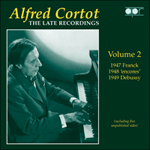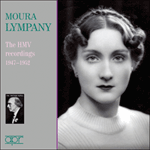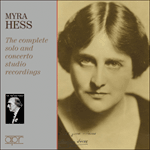
Welcome to Hyperion Records, a British classical label devoted to presenting high-quality recordings of music of all styles and from all periods from the twelfth century to the twenty-first.
Hyperion offers both CDs, and downloads in a number of formats. The site is also available in several languages.
Please use the dropdown buttons to set your preferred options, or use the checkbox to accept the defaults.

 PERFORMANCE
PERFORMANCE RECORDING
RECORDINGOn the whole it is the more bucolic aspect that Schumann explores, though these pieces are not without darker shadows. And while they may be technically fairly straightforward, their changeability calls for the quickest of reactions and a wealth of subtle nuance.
All seems well in the first number (Eintritt, ‘Entry’), its gently murmuring theme welcoming us into the forest in the most benign manner possible. The energetic Jäger auf der Lauer (‘Hunters on the lookout’), horn calls aplenty, gives the lie to the idea that Schumann—beset by personal demons by this point in his life—had lost his compositional way, and there’s a delightful mock-seriosity to the throwaway ending. The mood switches again in the next two pieces, Einsame Blumen (‘Lonely flowers’) and Verrufene Stelle (‘Place of evil fame’), tinged in turn by sadness and then a persistent unease that is only banished by the rollicking Freundliche Landschaft (‘Friendly landscape’), which is followed by a study in consolation and reassurance, Herberge (‘Shelter’). With No 7, the famous Vogel als Prophet (‘Bird as prophet’), Schumann seems to reach almost proto-Impressionistic realms, its central chorale-like section lending it an almost sacred gravitas. We return to compositionally safer, more pastoral territory with Jagdlied (‘Hunting song’), which presents an image of the play of horses’ hooves and the jolly red coats of the hunstmen, a notably child-friendly vision. With Abschied (‘Farewell’), the innocence of the opening seems to be regained as we bid the forest a poignant farewell.
from notes by Harriet Smith © 2014
Globalement, c’est le côté davantage bucolique que Schumann explore, encore que ces pièces ne soient pas sans ombres plus marquées. Et si elles peuvent se montrer techniquement assez simples, leur variabilité exige les réactions les plus vives et une profusion de nuances subtiles.
Dans le premier numéro (Eintritt, «Entrée»), tout paraît beau et le thème, doux murmure, nous accueille dans la forêt avec la plus grande bienveillance. L’énergique Jäger auf der Lauer («Chasseurs à l’affût»), où abondent les appels de cor, dément l’idée selon laquelle Schumann, assailli par ses démons, ne savait plus composer; la conclusion désinvolte affiche une charmante pseudo-gravité. Un nouveau changement de climat s’opère dans les deux pièces suivantes, Einsame Blumen («Fleurs solitaires») et Verrufene Stelle («Lieu maudit»), nuées par la tristesse puis par un malaise persistant seulement balayé par le berceur Freundliche Landschaft («Paysage amical»), avant Herberge («Auberge»), étude de la consolation et du réconfort. Le nº 7, le célèbre Vogel als Prophet («L’Oiseau-Prophète»), semble toucher à des sphères quasi proto-impressionnistes, sa section centrale façon choral lui conférant une gravité presque sacrée. Nous regagnons un territoire compositionnellement plus sûr, plus bucolique avec Jagdlied («Chant de chasse») et ses sabots de chevaux, ses gaies vestes rouges de chasseurs—une image remarquablement adaptée à l’enfance. Avec Abschied («Adieu»), l’innocence du début semble restaurée alors que nous adressons un poignant adieu à la forêt.
extrait des notes rédigées par Harriet Smith © 2014
Français: Hypérion
Im Großen und Ganzen befasst Schumann sich hier mit dem Bukolischen, obwohl die Stücke nicht ohne dunklere Schattenseiten sind. Technisch gesehen mögen sie relativ unkompliziert sein, doch verlangt ihre Wechselhaftigkeit gute Reaktionsfähigkeit und einen äußerst nuancierten Ausdruck.
In der ersten Nummer, Eintritt, scheint alles in Ordnung zu sein und das sanft säuselnde Thema heißt den Hörer in harmlosester Art und Weise im Wald willkommen. Die energischen Jäger auf der Lauer, wo zahlreiche Hornsignale erklingen, widerlegen die These, dass Schumann—zu diesem Zeitpunkt in seinem Leben heimgesucht von persönlichen Dämonen—sein Kompositionstalent verloren habe; das unvermittelte Ende ist von einer köstlichen Schein-Ernsthaftigkeit geprägt. In den nächsten beiden Stücken, Einsame Blumen und Verrufene Stelle, ändert sich die Stimmung wiederum; zunächst stellt sich eine Traurigkeit ein, die dann von einem hartnäckigen Unbehagen abgelöst wird, welches sich erst durch die Freundliche Landschaft vertreiben lässt, auf das eine Studie des Trosts und der Beschwichtigung—Herberge—folgt. Mit Nr. 7, dem berühmten Vogel als Prophet, scheint Schumann eine geradezu impressionistische Sphäre zu erreichen; der choralartige Mittelteil verleiht dem Stück eine fast geistliche Gravität. Danach kehren wir mit dem Jagdlied zu kompositorisch sichereren, eher bukolischen Gefilden zurück, wo sich ein Bild von galoppierenden Pferden und roten Jäger-Röcken präsentiert—eine bemerkenswert kinderfreundliche Vision. Mit Abschied scheint sich die Unschuld des Anfangs wieder einzustellen und es wird dem Wald ein ergreifendes Lebewohl gesagt.
aus dem Begleittext von Harriet Smith © 2014
Deutsch: Viola Scheffel
 Alfred Cortot – The Late Recordings, Vol. 2 - Franck, 'encores' & Debussy Alfred Cortot – The Late Recordings, Vol. 2 - Franck, 'encores' & Debussy'Documentation is good and the transfers too … these discs trace Cortot in the studio between 1947 and 1954 and reflect the vicissitudes of the t ...» More |
 Moura Lympany - The HMV Recordings, 1947-1952 Moura Lympany - The HMV Recordings, 1947-1952Moura Lympany (1916-2005) was the last of the major Matthay pupils and she started working with him in 1937 when he was already 79. In 1938 she shot to international fame when she came second to Emil Gilels in the Queen Elisabeth competition. A br ...» More |
 Myra Hess - The complete solo and concerto studio recordings Myra Hess - The complete solo and concerto studio recordings‘In one disc after another you are drawn towards a deeply personal quality that endeared her to thousands … this set will prompt endless reapprai ... ‘A stunning collection of music played by one of the most talented of British pianist’ (MusicWeb International)» More |

